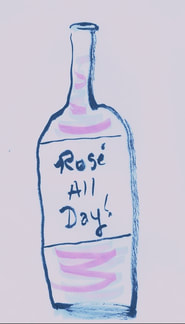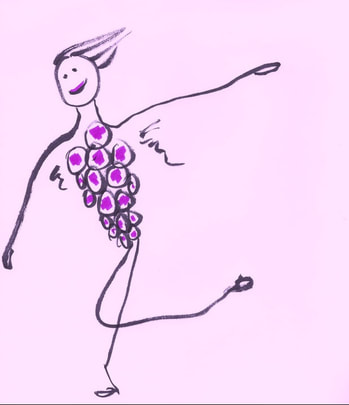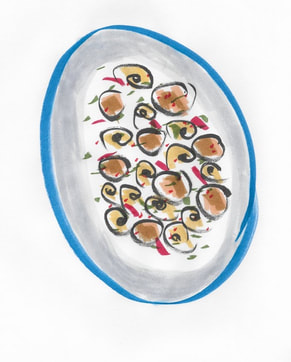 Garnacha is the one I would pour all over my face, in the town square, under the spotlight of the sun. Garnacha is the one I would pour all over my face, in the town square, under the spotlight of the sun. Have you ever met someone who causes you to lose all forms of self-control? For me, lusty Garnacha is the one I would pour all over my face, in the town square, under the spotlight of the sun. It would be reckless. Certainly illegal. It would be humiliating. And I would love every drop of that ruby red wine streaming out of the bottle and into my mouth. Onlooker shock would turn to bemusement at this shameless display of public affection. Intense relationships start hot, igniting the pleasure center in our brains, and Garnacha had me at hello. The origin of my intrigue with Garnacha lands squarely on the shoulders of Monica M., a key educator in my formal wine training and subsequent certifications. When wine classes are taught by a Spaniard, you quickly become curious about the wines of Spain and their many incarnations. I rummaged through the aisles of The Wine House in Los Angeles and picked up a bottle from Priorat, a hotbed of winemaking creativity and excellence in northeastern Spain. The bottle was a 2014 Mas Doix Les Crestes Priorat with a distinctive label featuring a rooster sporting a large red cockscomb. The wine was eighty percent Garnacha from twenty-year-old grapevines blended with ten percent old vine Carignan grapes and ten percent Syrah. Once home, I uncorked the bottle and just like that naughty Garnacha stole my heart. Red cherry, cranberry, strawberry, licorice and cinnamon aromas clouded my vision. I thanked my lucky stars for the pleasure that Garnacha gave me without reserve. But my conscience does not allow me to end the sweet memoir here. You, my friend, deserve more than a steamy love story. As with many affairs, there is a cautionary tale involved. While flooding your nose and mouth with spicy, red fruit flavors and aromas, Garnacha hides a dagger behind her back in the form of high alcohol. Garnacha’s alcohol by volume ranges from thirteen point five to sixteen percent; fifteen percent is very common. So you see, you will never be able to love her with the complete abandon she accords you. Tragically, Garnacha will always be the superior lover in this relationship, so keep your dignity, if you can, by girding your loins against the mischievous alcohol that is skillfully concealed by the best makers. The Mas Doix I drank that day, for example, was fourteen-point-five percent ABV. It is this very attribute of high alcohol, along with a full body, that attracted Burgundian winemakers in the seventeenth century to add her to their Pinot Noirs to make them more interesting. Experienced lovers have mysterious pasts, and Garnacha is no exception. There has been a tug-of-war among wine lovers about the origin of this grape. Some feel that Garnacha originated in Aragon in northern Spain. Others insist she was born in Sardinia. Like many, I am inclined to believe that she is of Aragon because this area has the widest range of Garnacha varieties (red, white, grey, Peluda). More importantly, Garnacha’s clonal diversity in Aragon eclipses that of Sardinia. Garnacha’s parents are unknown. She holds tight to her secrets.  She is an avid sunbather, even though she is thin-skinned, and she tolerates drought conditions with aplomb. She is an avid sunbather, even though she is thin-skinned, and she tolerates drought conditions with aplomb. The only way to know enigmatic Garnacha is to experience her attributes in the here and now. Garnacha has many hot spots of production, literally, as she prefers a warm or hot climate. She is an avid sunbather, even though she is thin-skinned, and she tolerates drought conditions with aplomb. In no hurry to impress, Garnacha is a late ripening grape; she takes her time. Pick her grapes too early and she cannot reach her peak of perfection. Her generous body is there strictly for your pleasure. Most famously, she is the key grape in the Southern Rhône’s Châteauneuf-du-Pape wines, where she is known fondly by her friends as Grenache. Châteauneuf wines showcase delicious Grenache, often with the blending partners of Syrah and Mourvèdre, to create full-bodied wines of spicy, concentrated red and black fruit. In vintages with hotter climates, Grenache can get overly jammy, so her blending partners help balance the final wine with tannins, color, acidity, and layered flavors. In some cases, such as Château Rayas, the very finest Châteauneuf is composed of one-hundred percent Grenache in lieu of using any of the thirteen permitted grape varieties for producing red Châteauneuf. An older vintage from Rayas can put you back two-thousand dollars for a single bottle. How does Château Rayas manage to produce what may be the Southern Rhône’s finest wines without the help of blending partners to correct her soft tannins and low acidity? For one thing, Rayas, located in the northeastern area of Châteauneuf-du-Pape, enjoys the coolest microclimate in the Southern Rhône, so the grapes are unlikely to be over-baked and flabby. Trees and forests exert a cooling influence on the soil. These advantages result in naturally lower yields and longer hang time for the grapes, turning up the dial on flavor intensity. With less heat, the grapes at Rayas preserve their precious acidity. Grapevines, under these conditions, grow at a pace conducive to tannin concentration. The terroir at Château Rayas makes it possible to harvest the grapes later in the season, at their perfect level of ripeness, without driving up the sugar level. The result: fresh, pure, silky wines that are lower in alcohol than those of many counterparts. In short, this wine is the very essence of elegance. The Dutch Golden Age painter Johannes Vermeer would have watered at the mouth to paint this Grenache beauty, a real pearl of a wine. Grenache is the most planted variety in the Southern Rhône. About half of the Southern Rhône’s wine production is labeled simply as Côtes du Rhône, and these are fruity, simple, medium-bodied red, white or rosé wines meant for casual consumption. If you thirst to investigate wines of a more serious nature, you can trade up to offerings that fall under the Côtes du Rhône Villages appellation. These wines have strict laws that address alcohol levels, permitted yields, and wine grape composition, along with other aspects of winemaking. The very best wines are cru wines, such as the Château Rayas from Châteauneuf that we discussed. A cru is a legally distinct region that is recognized for its quality and unique terroir. In Châteauneuf, many growers claim their vines are over one hundred years old. This age on Grenache contributes greatly to building a wine with deep flavors. Southern Rhône crus include Châteauneuf-du-Pape (the original cru of the Southern Rhône), Tavel and Lirac (best known for their Grenache-based rosés), Gigondas, Rasteau, Beaumes de Venise, Vacqueyras, Cairanne, and Vinsobres. By the way, Gigondas, located just ten miles away from Châteauneuf, provides a similar style of wine at a much lower price point. The wine there is getting so good that even experts may not be able to distinguish it from a Châteauneuf wine, but you will know the difference, expert or not, at the cash register. If you were standing in the middle of a typical vineyard in the Southern Rhône, you would find Grenache’s vines to be bush-trained, clinging low to the ground. This helps her withstand the area’s powerful north winds, known as the mistral. As you stood in the vineyard taking in the songs of the birds and thinking that life is good, you would marvel at the bounty of large stones covering the vineyard’s soil. The stones, known as galets, evoke a moon-like appearance. Why are they there? They absorb the sun’s rays during the day and warm the vineyards through the night. Go ahead . . . crouch down . . . touch the stones . . . and feel the warmth. This is old-school technology at its best, creating ripening conditions for our lovely growing girl. Grenache is also found in France’s Languedoc-Roussillon wine region, where she courts several blending partners such as Syrah, Mourvèdre, Carignan and Cinsault.  Grenache is one of the dominant varietals used in making the Provence rosé blends that are so hot right now. Grenache is one of the dominant varietals used in making the Provence rosé blends that are so hot right now. Grenache is one of the dominant varietals used in making the Provence rosé blends that are so hot right now. Her thin skin produces less color than, for example, a thick-skinned cabernet sauvignon grape that is rich in coloring matter. Lack of color makes Grenache an ideal blending grape for the production of the pale rosés that consumers fancy. I recognize Grenache anytime I taste her in a blend, especially in a rosé. As waves of wine roll around my tongue, it is as though Grenache’s blending partners evaporate, leaving her completely exposed, and (guess what?!) she doesn’t care. Grenache flaunts her flavors like nobody’s business. Back in Spain’s increasingly acclaimed Priorat wine region, classic blends are composed of old vine Garnacha and Carignan (known as Cariñena in Spain). The very best examples from this region are full-bodied and minerally, with flavors that might include a complex weave of brandied cherries, tar and licorice. These wines command some of the highest prices in the world. Priorat’s vineyards are hot and dry, much to Garnacha’s delight. Old grapevines struggle in nutrient-poor soils to produce very low yields and mouth-watering flavors. In the Rioja wine region of Spain, Garnacha contributes body, alcohol, and heady flavors and aromas to Tempranillo, the dominant variety there. While the neighboring Rioja and Navarra regions focus on Tempranillo-based wines, the Calatayud and Cariñena wine regions of Spain claim Garnacha as their most favored grape. Sardinia is a real player in the world of Garnacha, and on this island she is known as Cannonau. The Cannonau di Sardegna appellation covers the entire island. Many feel that the best examples are found on the eastern side. Italian scientists have unearthed information suggesting that Cannonau originated in Sardinia, not Aragon, so the ongoing tug-of-war over Garnacha’s birthplace will continue until indisputable proof surfaces. From time to time, my clients ask me to recommend a wine for medicinal or health purposes. Personally, I love this because it makes me feel like Doctor Lyne, though it is beyond my pay grade. In these cases, I sometimes call upon Cannonau’s restorative powers. Buyers get excited when they learn that Sardinian locals have extraordinarily long lifespans. We are talking about people who live into their nineties or to over one hundred years old. Some attribute this longevity to the Sardinian diet, including the wine. Cannonau is high in anthocyanins and polyphenols, antioxidant compounds that are thought to contribute to heart health. Who am I to challenge this thinking? The Sardinians are doing something right. You will also find Garnacha south of Sardinia on the island of Sicily, where the locals call it Alicante. Garnacha is a jet-setter, growing well in Australia’s Barossa Valley and McLaren Vale, and you will spot her on California’s Central Coast as well as South Africa and Israel.  Garnacha Peluda is a variant of red Garnacha with the underside of the leaves displaying a peculiar hairy appearance, almost as though she forgot to shave her armpits. Garnacha Peluda is a variant of red Garnacha with the underside of the leaves displaying a peculiar hairy appearance, almost as though she forgot to shave her armpits. Garnacha expresses herself in varieties beyond the ruby red, known in Spain as Garnacha Tinta and in France as Grenache Noir. Garnacha Blanca, the white wine grape, is being produced as a one hundred percent varietal with a golden hue and a full body in Priorat and other Garnacha-centric Spanish wine regions. Look for characteristics that include floral notes, citrus, and ripe stone fruit accented with pinches of rosemary and thyme. Throughout the south of France, Grenache Blanc is produced as an easy drinker with low acidity and high alcohol, often presented with its traditional blending partner, Maccabéo. Châteauneuf-du-Pape produces white offerings, Grenache Blanc among them, that are weighty and intensely aromatic. You will also find Grenache Blanc on California’s Central Coast, especially San Luis Obispo. Garnacha comes in classic gray as well but it has limited worldwide production. Look for it in the south of France, where it goes by the name of Grenache Gris. This wine exudes apricot and stone fruit aromas and some examples have a satisfying, oily mouthfeel. It is a bit of an obscure wine but that in itself is interesting for those of us who are always on the lookout for something new. There is some production of this grape in Spain, South Africa and California. Grenache Gris is genetically one and the same as Grenache Noir and Grenache Blanc but simply has a pinkish-gray skin. Even though this grape is relatively rare, many feel that she is blessed with a more profound flavor than her white sister. Now we get to the hairy proposition of Garnacha Peluda. This is a variant of red Garnacha with the underside of the leaves displaying a peculiar hairy appearance, almost as though she forgot to shave her armpits. Clearly, this is the more earthy side of Garnacha. Peluda is planted throughout Spain and in southern France and has a lower alcohol content than traditional Garnacha. It is not unusual to find red Garnacha and Peluda in the same vineyards and they are often mixed together in fermentation and/or blending. What should you eat while drinking red Garnacha? The good news is that Garnacha is one of the world’s most versatile wines for pairing with food, mostly due to her pure red fruitiness, hint of citrus and other refreshing qualities. Her wide range of depths and textures, along with a kick of spice, are ideal with braised, grilled or stewed meats such as chicken, veal, lamb, beef, game and pork. Garnacha also pairs nicely with salmon and trout, especially when grilled. Match Garnacha’s spiciness with Indian food, though I would steer clear of very highly spiced food of any kind as wines that are high in alcohol make hot, spicy food taste even hotter. If you are not in the mood for meat, call on Garnacha for pairing with a mac and cheese dinner or a lentil- or bean-based dish. For white or gray Garnacha, as well as rosés, seafood is a natural. Think about fish tacos, crab cakes and garlic prawns. If you have read my blog post on food and wine pairings, you know that choosing wines that match the origin of the food is one way to start getting creative with your dinner planning. It is no surprise, then, that all colors of Garnacha pair well with the quintessential Spanish dishes of charcuterie and paella. Some winemakers harness Garnacha’s naturally high levels of alcohol and sugar to produce a fortified dessert wine known as Vin Doux Naturel. Drink this style on its own or pair it with dark chocolate, caramels, brownies, and cookies. These desserts also pair well with most other styles of Garnacha. If you are planning a cheese course with Vin Doux Naturel wine, you can reach for Brie, blue cheese, Cheddar, Gouda, Gruyère, and Manchego. I’ll let you in on a little secret: Spanish wines are among the best values available on the market. Many of the wines you already enjoy share some of the same characteristics found in red Garnacha and you may be able to pay less for the same quality by switching. If you get weak at the knees for Syrah, Amarone, Mourvèdre, Tempranillo, or even Merlot, consider a tryst with Garnacha. There, I’ve gone and done it again. This story is longer than most because I have, once more, lost all control when it comes to Garnacha. If you find yourself falling in love with her, it hurts me to tell you that you will be one of a long line of lovers. The awful truth may bruise your ego, but you will, in time, learn to accept Garnacha as she is and without complaint. In fact, the only way to upset her is to ignore her on the third of September, International Grenache Day. But you won’t do that because you want to have her around all the time. A bad day with Garnacha is better than a good day with anyone else, even if she leaves you crying on the street and making a public spectacle of yourself, yet again. Take my advice and resolve yourself to the fact that Garnacha is a woman you can’t forget . . . and that you will never leave. Garnacha: General Characteristics Flavors: cherry, raspberry, blackberry, candied fruit roll-up, cinnamon, white pepper, citrus skin, licorice, tobacco, oregano, lavender Acidity: low to medium Tannins: low to medium Texture: soft tannins Alcohol: high Body: medium- to full-bodied Key regions: Spain: Priorat, Rioja, Calatayud, Cariñena, Navarra, Montsant; Italy: Sardinia, Sicily; France: Southern Rhône, Châteauneuf-du-Pape, Languedoc-Roussillon, Gigondas; Australia: Barossa Valley, McLaren Vale; United States: California’s Central Coast Parents: unknown Origin: most likely Aragon in Northern Spain; possibly Sardinia Also known as: Grenache, Grenache Noir, Garnacha Tinta, Garnatxa, Cannonau, Cannonau di Sardegna, Lledoner, Tinto Aragones, Alicante, Granaccio
1 Comment
 Don’t be surprised by the presence of almond on the nose. Don’t be surprised by the presence of almond on the nose. On the morning my mother passed away in my arms, I drove from Vista in San Diego County to Los Angeles. The two hours of driving north gave me time to reflect on how lucky I had been to hold my mother during her last twenty-four hours, massaging her head and arms as she took her personal journey. Instead of driving straight home, I made two stops: Santa Monica Seafood, where I purchased some plump scallops, and The Wine House, where I procured a bottle of white wine from Sardinia. This night, August 6, 2019, I would make a fine meal of pasta with scallops and sun-dried tomatoes accompanied by a white wine worthy of celebrating my mother’s life: a 2018 Vermentino by Antonella Corda. When you spot a glass of Vermentino on a wine list or reach for a bottle at your local shop, the producer is most often located on the island of Sardinia, an ancient land mass that is one of over four-hundred-and-fifty islands under the Italian flag. Sardinia, second in size only to Sicily, is known by locals as Sardegna, and you will often see this place name on the wine label. Sardinia is responsible for the production of about half of all Vermentino worldwide. Vermentino Di Gallura is Sardinia’s only DOCG (Italy’s highest designation of quality), and it is located in the northeast area of the island. Gallura is prized for its breathtaking beauty, granite soils, and famous Emerald Coast. While Sardinia was once regarded as Italy’s wild west, today it is the darling of nearly ten million tourists who visit annually. If you are an ambitious swimmer with a penchant for chasing Vermentino, you can make your way seven miles north from Sardinia to French Corsica. There, Vermentino goes by the name of Vermentinu in accordance with local naming traditions. In fact, this grape goes by several names, depending on where you are drinking at the moment. On Italy’s mainland, Vermentino is prominent in Liguria, home of the ritzy Italian Riviera. Here, the wine known as Pigato, a name that means “spotted,” because the grapes have freckles on their skin. In northwest Italy’s Piedmont region, the grape is called Favorita. A quick flight over to Southern France’s Provence and Languedoc-Roussillon wine regions will further acquaint you with this popular variety, which they call Rolle. The French there use Rolle in their production of rosé to lighten the color and to provide intriguing aromas and mouthfeel. Come to think of it, I hope that this thin-skinned grape won’t be offended as I notice that it runs with a monied, sun-seeking Mediterranean crowd. Vermentino shines at its best when planted close to the sea and you know that real estate isn’t cheap. You can also find Vermentino produced in California’s Paso Robles, Sierra Foothills, and Lodi regions, where it is appreciated for its resistance to drought and disease. There has always been confusion as to the origin of the grape, but DNA testing has most people convinced that Vermentino is native to Italy. When a server approaches you on a hot summer day with a glass of Vermentino, the aromas from the pale gold nectar will reach your nose before the wineglass, wet with condensation, hits the table. Vermentino discharges a heady mix of that may include grapefruit, lemon peel, lime, pineapple, green apple, white peach, pear, and white flowers. These fragrances are couched in savory accents of sage or scrub-brush, depending upon the vineyard location and the hand of the winemaker. Don’t be surprised by the presence of almond on the nose: this is a defining aroma of the wine. Vermentino is known for having an almost salty minerality redolent of the vineyards located along the western Mediterranean. The grapevines located on beachfront properties are natural recipients of the saltwater elements that shower their soils, grape skins and leaves. Gusty winds along the coast cool the grapes and dry them out, helping them retain their medium- to medium-high acidity. A medium alcohol level of eleven point five to thirteen point five ABV contributes to Vermentino’s refreshing quality. Vermentino is the Gemini of wine grapes, presenting you with two vastly different style possibilities. Light-bodied, easy-drinking Vermentino wines are an inviting alternative to a Sauvignon Blanc or a bone-dry Muscadet. Producers of this light style seldom use oak, instead favoring stainless steel and other neutral vessels to preserve this variety’s mix of aromas. The moment you meet the rich, opulent and sometimes creamy expression of Vermentino, you will know why I chose this style for a night of importance and reflection. This weightier style might greet you with bruised pear, sage, wet earth, brioche and almonds with a nice hit of acidity keeping everything on balance. A 2018 bottle of Vermentino Di Gallura by Piero Mancini that I am enjoying at the moment hits all of these notes, along with a generous, oily texture in the mouth. This round mouthfeel often indicates time on lees (resting time in the vessel with the yeast that fermented the wine). Creamy or dairy aromas and flavors might be introduced by the winemaker, who employs the malolactic fermentation technique to convert tart malic acid into creamy lactic acid. This bottle by Mancini, a one-hundred percent Vermentino, has a satisfying aromatic intensity and is typical of Vermentino’s medium level of alcohol at twelve point five ABV. In Tuscany’s Bolgheri village (home of Super Tuscans), Vermentino sees some of its very richest expressions, where producers rely on the interplay of skin contact, time on lees, and barrel aging to create wines of weight and extraordinary complexity. If you enjoy a rich Viognier or a Napa Valley Chardonnay, this form of Vermentino may just hit the spot. While some Vermentino wines can be aged, most should be enjoyed within three to seven years following the vintage. The Vermentino tasting experience holds yet another twist: a slightly bitter finish that reminds you of the sensation you get in the mouth from a grapefruit pith or a young almond. This counterpoint to the citrus and flower notes refreshes your palate in preparation for the next sip. Think about this sensation like you would the tannins in a red wine — a balancing component to fruity and juicy elements. What causes this unusual aftereffect? The Vermentino grape has a high level of phenolic compounds that produce a sophisticated, bitter finale. (Phenolic compounds naturally occur in plants and are valued for their antioxidant properties which are thought to reduce the risk of disease.) Considering that Italy is fond of including bitter elements in its cuisine, such as radicchio, it is fitting that this wine is not shy about rewarding us with a light kiss of bitterness.  On this night, I would make a fine meal of pasta with scallops and sun-dried tomatoes. On this night, I would make a fine meal of pasta with scallops and sun-dried tomatoes. Which foods pair well with Vermentino? My first thought for pairing food with a particular wine is to take a look at where the wine comes from and match it with foods from the same area. Ergo, why not cook up some Mediterranean food to go with your Vermentino? Your first course could be a tip of the hat to Vermentino’s citrusy character featuring an arugula salad bathed in olive oil, lemon and parmesan cheese. The arugula’s herbaceous and somewhat bitter elements are also a nifty match to the wine’s characteristics. Celebrate Vermentino’s oily mouthfeel by grilling up some sea bass, red snapper, octopus, squid, or sardines. And you don’t have to stop there while at the grill. Vermentino is a great dancing partner for grilled chicken or even lean red meats such as pork and lamb. Play on Vermentino’s savory notes by roasting artichokes, onions, peppers, sweet potatoes or eggplant. If you are in the mood for pasta, bathe it in pesto sauce to boost Vermentino’s herbal aspects. The next time you visit a local bistro for lunch, order up a spinach quiche to go with your Vermentino. The rich, creamy mouthfeel of the quiche, along with the bitter green flavors of the spinach make this meal an ideal fit for your wine. Don’t hesitate to pair Vermentino with chicken or fish tacos on a Taco Tuesday. Vermentino is a wine with personality plus, and a lot of nuance, so have fun matching and contrasting the aromas and flavors that she has to offer. I look for Mediterranean offerings along the lines of bitter salads, nuts, citrus, fish, stone fruit, oils, and cheeses with a creamy mouthfeel like Mozzarella. For additional food and wine pairing ideas, see my new book, Your Love Affair with Wine, available on Amazon. I saved the best news for last: your awareness of Vermentino as a white-wine option is good for the pocketbook. Many wine drinkers are unaware of the existence of this grape, so you may find yourself paying less than you might for a Sauvignon Blanc (light style) or a Chardonnay (rich style) of similar quality. While we’re thinking about it, let’s look at wines with similar profiles to Vermentino. When you run into these wines at the bottle shop, consider whether Vermentino is a better value. If you are shopping for fresh, light-bodied whites, you might be looking at a Sauvignon Blanc with its green apple, citrus and white peach aromas like Vermentino. How do the two wines differ? For one thing, the Sauv Blanc is likely to have higher acidity. Perhaps you could tell these wines apart in a blind tasting on that one feature alone. Or, you could be looking to pick up a bottle of Muscadet. This wine, produced in France’s Loire Valley, is dry and saline with citrus characteristics like a Vermentino. However, Muscadet wines are generally dryer and more acidic. If I was blind tasting between the two, I would identify the wine that is bone dry (Muscadet) and sniff like a bloodhound for almonds (Vermentino). Like Vermentino, Muscadet thrives near the water, but it lives in a cool climate whereas the Vermentino longs to bask like a sunbather in a warm or hot climate. Let’s say you want to pick up a Manzanilla Sherry. Like a Vermentino, you would anticipate almond aromas, salinity and a slightly bitter aftertaste. Yes, both wines share these refreshing attributes, but with Manzanilla’s ABV of fifteen to seventeen percent, you would immediately know the difference. Manzanilla has low acidity whereas a Vermentino has medium to medium-high acidity. If you are shopping for a rich, opulent white, you might be looking at a warm-climate Chardonnay, such as one from Napa Valley. This wine can offer Vermentino’s round mouthfeel and creaminess, along with nuttiness and tropical fruit notes. Chardonnay can be made in a variety of styles, like Vermentino, and may also undergo malolactic fermentation. However, an oaky, warm-climate Chardonnay is predisposed to having a lower acidity level than Vermentino. A Viognier might be on your shopping list, with its almond, citrus and peach aromas as well as an oily mouthfeel. How would you possibly tell it apart from a Vermentino? Viognier is usually lower in acidity and higher in alcohol. Or, you might be reaching for a golden Semillon wine from South Australia, with its tropical, nutty qualities balanced by a chalky minerality and an oily mouthfeel. The way to identify which is which in a blind tasting: Semillon customarily has a higher alcohol level. Our memory of a wine is brought into focus when we pair it with life events, connection with family and friends, and meaningful experiences. For me, the Vermentino grape will be inextricably tied to my mother and her loving and nurturing role in my life. When I drink Vermentino, I will think of her. When I think about my mother, I will remember the pasta dinner, the Vermentino and the conversation with my husband. Peter and I had a quiet dinner at home that night of August sixth. We discussed everything that had happened with my mother over the past several days and hours. At eighty-six, my mother had lived a generous time on earth, but it was still difficult to say goodbye. The next day, I called my daughter, Nicolette, and asked her to make the same meal and to pair it with Vermentino should she find herself in the position of celebrating my life. Ever the chef, Nicolette reminded me that scallops may not be in season at the end of my days. We struck a deal, however: a glass of Vermentino from Sardinia would be raised in my honor, as I had done for my mother. The seafood: Chef’s choice. Vermentino: General Characteristics Flavors: citrus, green apple, pineapple, white flowers, almond Acidity: medium to medium-high Phenolics: attractive bitterness on the finish Texture: fresh and light to lush and oily Alcohol: medium Body: light to full Key regions: Italy: Sardinia, Liguria, Tuscany, Piedmont; France: Corsica, Provence and Languedoc-Roussillon; US: Paso Robles, Sierra Foothills, Lodi. Parents: Unknown Origin: Likely Italy Also known as: Rolle, Favorita, Favorita Bianca, Favorita d’Alba, Pigato, Vermentini, Vermentinu, and Malvoisie de Corse. |
AuthorLyne Noella Archives
October 2022
Categories
All
|


 RSS Feed
RSS Feed
